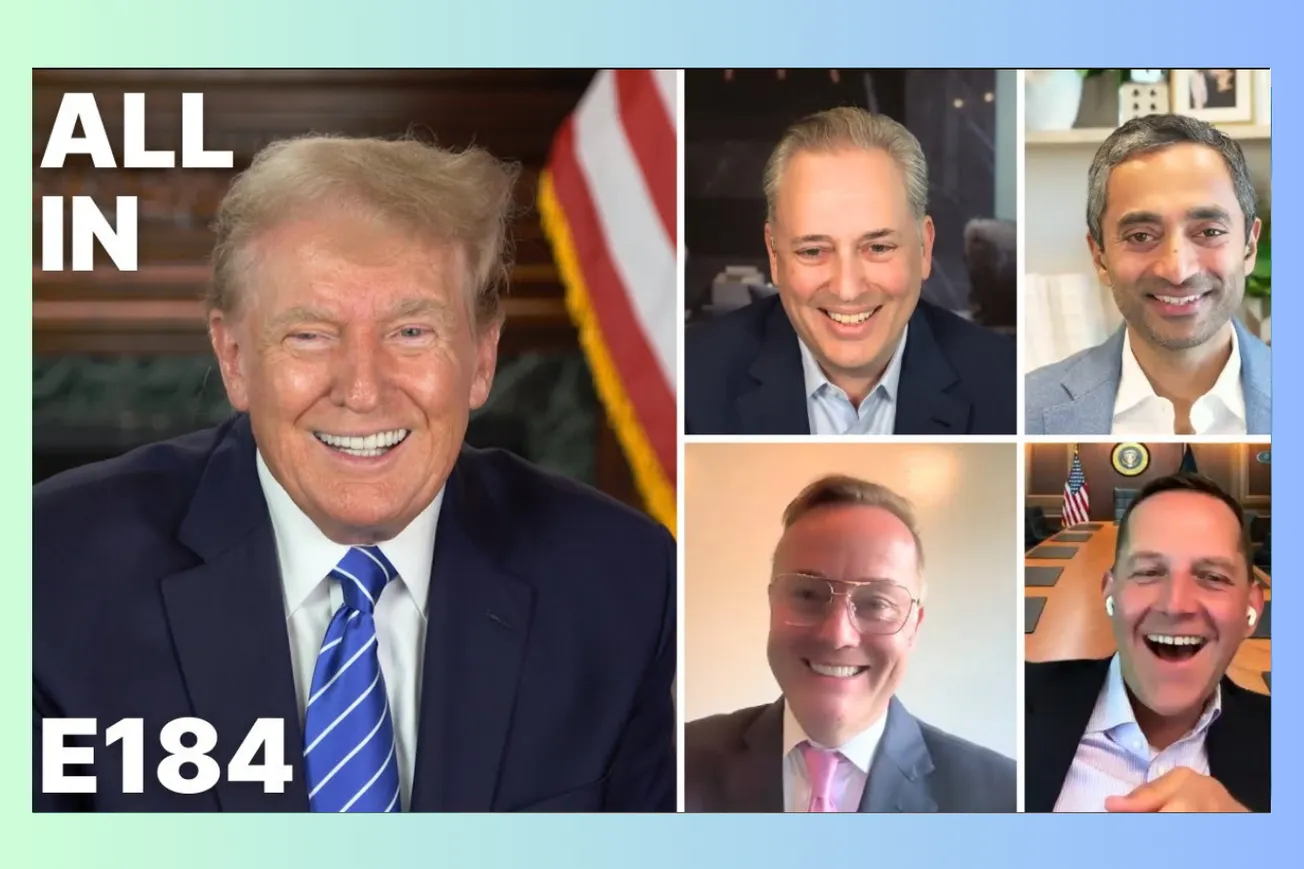Table of Contents
President Trump discusses tax cuts, tariffs, Ukraine policy, abortion stance, and tech immigration reform in comprehensive All-In Podcast interview.
Key Takeaways
- Trump reaffirms commitment to extending his corporate tax cuts from 40-45% to 21%, with regulation cuts being even more impactful than tax reductions for business growth
- Supports automatic green cards for all college graduates including community college students to keep top talent in America rather than losing them to competitors
- Definitively opposes national abortion ban, stating the issue belongs with individual states and respecting democratic referenda outcomes at state level
- Plans immediate release of remaining JFK files and other classified documents for transparency, believing previous advisors incorrectly counseled against disclosure
- Will not deploy American troops to Ukraine under any circumstances, understanding NATO expansion as primary driver of current conflict
- Proposes reciprocal trade agreements where countries face identical tariffs they impose on American products to level global playing field
- Emphasizes massive electricity needs for AI competitiveness requiring nuclear and traditional energy rather than renewable-only approaches
Timeline Overview
- 00:00–01:37 — Bestie Intros and House Talk: Opening pleasantries about David Sacks' impressive house and Trump's Mar-a-Lago property valuation controversy, setting a relaxed tone for the conversation
- 01:37–12:02 — Economic Policy Focus: Deep dive into regulation and tax reduction as Trump's primary business growth strategies, explaining why business leaders consistently ranked deregulation above even massive tax cuts in importance
- 12:02–20:22 — Federal Debt and Spending Control: Discussion of debt accumulation under both administrations, growth-focused solutions through energy independence, and specific plans for reducing bureaucracy starting with Department of Education
- 20:22–25:05 — Ukraine and Russia Foreign Policy: Trump's definitive stance against American boots on the ground, analysis of NATO expansion as war catalyst, and commitment to negotiating peace deals
- 25:05–28:13 — Israel and Palestine Conflict: Explanation of how Iran's economic empowerment under Biden enabled Hamas funding, contrasting with Trump's sanctions that left Iran financially constrained
- 28:13–31:09 — Abortion Policy Position: Clear rejection of national abortion ban, support for state-level decision making, and acknowledgment that state referenda are producing varied outcomes
- 31:09–32:33 — China Relations and Trade: Assessment of war likelihood with China as unlikely under proper leadership, criticism of Biden's perceived weakness and conflicts of interest
- 32:33–39:39 — COVID Origins and Deep State: Trump's role in stopping gain-of-function funding to China, relationship with Fauci, and broader discussion of embedded institutional resistance
- 39:39–46:07 — Border Security and Immigration: Border wall construction achievements, criticism of Biden's policy reversals, and breakthrough commitment to automatic green cards for college graduates
- 46:07–48:06 — JFK Files and Government Transparency: Promise to immediately release remaining classified documents, admission that CIA-adjacent advisors previously influenced his decision to withhold information
- 48:06–50:15 — Presidential Debate Predictions: Trump's respect for Biden's past debate performance against Paul Ryan while maintaining confidence in his own preparation and capabilities
Economic Growth Through Deregulation and Tax Reform
Trump positioned regulatory reform as the cornerstone of his economic agenda, revealing insights from extensive conversations with corporate leaders about the relative impact of his signature policies.
- Corporate tax reduction from 40-45% (including state and local) to 21% represented the largest tax cut in American history, generating record revenues despite lower rates
- Business leaders consistently ranked Trump's regulation cuts as more impactful than even the massive tax reductions for enabling investment and growth
- Regulatory streamlining made it "possible to build" and "possible to invest" by removing bureaucratic barriers that had paralyzed business development
- Apple exemplified the repatriation success, bringing hundreds of billions back from overseas after rate cuts and structural reforms eliminated punitive barriers
- The combination of reduced corporate rates and eliminated regulatory obstacles created the foundation for record job creation and economic expansion
Trump's emphasis on regulation over taxation reflects a sophisticated understanding of business constraints, where compliance costs and approval delays often exceed tax burdens in their impact on competitiveness.
Reciprocal Trade and Tariff Strategy
Rather than blanket protectionism, Trump outlined a targeted approach using tariffs as both economic and diplomatic tools to address trade imbalances and foreign policy challenges.
- Reciprocal Trade Act would impose identical tariffs on countries that restrict American products, creating symmetrical rather than punitive trade relationships
- China's 100% tariff on American cars should trigger equivalent US tariffs on Chinese vehicles to establish fair competition rather than one-sided disadvantage
- European Union's restrictions on American farm products and automotive exports justify corresponding limitations on EU access to American markets
- Tariffs provide political leverage beyond economic benefits, offering negotiating power when countries take actions contrary to American interests
- Strategic tariff deployment can prevent dollar abandonment by making alternative currency arrangements economically costly for trading partners
This framework positions tariffs as corrective mechanisms rather than permanent barriers, aimed at achieving reciprocity rather than isolation.
Federal Spending and Bureaucratic Reform
Trump acknowledged the debt challenges while proposing growth-oriented solutions combined with targeted bureaucratic reductions to address long-term fiscal sustainability.
- COVID-era spending under Trump addressed genuine depression risk, contrasting with Biden's continuation of massive spending without similar justification
- Energy independence through increased domestic production can generate growth that helps manage debt burdens while reducing foreign dependence
- Department of Education elimination would return control to states while providing them half the current federal funding, creating better outcomes at lower cost
- States like Nebraska and Iowa can deliver superior educational results for fractions of current federal per-pupil spending through local accountability
- Environmental and Interior Department functions can transfer to states, reducing Washington bureaucracy while maintaining necessary oversight and protection
The approach emphasizes federalism and efficiency over centralized control, reflecting confidence that local governance often outperforms federal management.
Ukraine Conflict and NATO Expansion
Trump provided his clearest foreign policy position on Ukraine, emphasizing American non-involvement while identifying root causes of the conflict.
- Absolute commitment that American troops will never be deployed to Ukraine under his presidency, regardless of European allies' decisions
- NATO expansion promises, particularly Biden's statements about Ukraine membership, created predictable Russian reaction and conflict escalation
- Blinken's communication to Lavrov about potential nuclear weapons placement in Ukraine represented dangerous provocation that pushed Russia toward military action
- Europe should bear primary financial responsibility given geographical proximity and direct security interests in the conflict outcome
- Oil price increases enabled Putin's war financing, highlighting the connection between energy policy and international security
This analysis frames the conflict as preventable through different diplomatic messaging and energy policies rather than inherent Russian aggression.
Israel-Palestine and Iran Strategy
Trump contrasted his Iran containment approach with Biden's policies that enabled regional destabilization and the October 7th attacks.
- Iran sanctions under Trump left the regime financially constrained, unable to fund Hamas, Hezbollah, and other terror organizations effectively
- Abraham Accords represented significant progress toward regional peace, with Iran potentially joining if Trump had remained in office
- Biden's sanctions relief allowed Iran to accumulate $250 billion in three years, directly funding regional terror operations and weapons programs
- Iran's nuclear capability timeline has accelerated to potentially 90 days, creating existential threat to Israel and complicating future negotiations
- Simple framework of preventing Iranian nuclear weapons while allowing conventional energy development could have achieved regional stability
The emphasis on economic leverage over military intervention reflects Trump's preference for financial pressure as a primary foreign policy tool.
Abortion Policy and State Rights
Trump definitively rejected federal intervention in abortion policy, positioning himself as respecting democratic processes at state levels.
- No support for national abortion ban, emphasizing that the issue properly belongs with state governments and voters
- Supreme Court appointments successfully returned the issue to states as intended by legal scholars across the political spectrum
- State referenda are producing varied outcomes, with some more liberal than expected (Ohio, Kansas) and others more conservative (Texas)
- Support for traditional Republican exceptions: rape, incest, and life of the mother, following Ronald Reagan's precedent
- Opposition to late-term abortion practices, particularly citing former Virginia Governor's comments about post-birth decisions
This position attempts to balance conservative judicial philosophy with political pragmatism, avoiding federal overreach while maintaining core principles.
China Relations and Economic Competition
Trump assessed the likelihood of military conflict with China as low under proper American leadership, while acknowledging the competitive challenges.
- Personal relationship with President Xi facilitated effective diplomacy until COVID created tensions over virus origins and global impact
- Biden's perceived weakness and family financial ties to China compromise American negotiating position and invite Chinese contempt
- War with China is "unlikely" under competent American leadership that commands respect rather than ridicule from Chinese leadership
- COVID's origin in Wuhan lab caused global deaths and $60 trillion in economic damage, creating legitimate grievances requiring acknowledgment
- Proper presidential leadership can maintain peaceful competition while protecting American interests through strength rather than confrontation
The framework emphasizes diplomatic capability and economic competition over military preparation, reflecting confidence in American advantages when properly leveraged.
Immigration Reform for Economic Competitiveness
Trump delivered potentially groundbreaking policy commitments on high-skilled immigration that could transform American talent acquisition strategies.
- Automatic green card provision for all college graduates, including community college students, represents dramatic expansion of legal immigration pathways
- Current system forces top graduates from Harvard, MIT, and other institutions to leave America, benefiting competitor nations with American-trained talent
- Brilliant international students create companies worth billions in their home countries that could have been built in America with proper immigration policies
- Tech industry talent requirements demand smart people beyond current workforce capacity, necessitating global recruitment rather than domestic limitation
- Day-one implementation promised for automatic graduate green card program, addressing immediate tech industry staffing needs
This represents a significant evolution in Trump's immigration messaging, distinguishing between border security and high-skilled talent acquisition.
Government Transparency and Deep State Reform
Trump committed to unprecedented transparency measures while acknowledging institutional resistance to disclosure of sensitive information.
- Immediate release of remaining JFK files represents commitment to transparency over institutional preferences for secrecy
- Previous advisors whom Trump "respected" counseled against full disclosure, but second-term approach will prioritize public access over bureaucratic concerns
- Additional classified document releases planned beyond JFK files, though specific details reserved for private discussion
- CIA and related agencies influenced first-term decisions through appeals to national security, but transparency benefits outweigh secrecy costs
- Public demand for JFK files reflects broader desire for government accountability and institutional trust restoration
The transparency agenda positions disclosure as essential for rebuilding public trust in government institutions rather than protecting bureaucratic preferences.
Common Questions
Q: Will Trump's tariff policies cause inflation as Larry Summers predicted?
A: Trump respects Summers' analysis but believes tariffs provide both economic and political leverage, with reciprocal rather than punitive implementation preventing stagflation.
Q: How will Trump control federal spending that has grown under both administrations?
A: Growth through energy independence combined with bureaucratic reduction, starting with Department of Education elimination and state-level governance improvements.
Q: What makes Trump confident he can negotiate better deals than previous administrations?
A: Personal relationships with foreign leaders, willingness to walk away from bad deals, and understanding of American economic leverage in negotiations.
Q: Why does Trump believe his immigration policy won't hurt American workers?
A: High-skilled immigration creates jobs rather than eliminating them, while border security prevents wage depression from illegal immigration.
Q: How will Trump handle institutional resistance to his transparency agenda?
A: Second-term approach will prioritize public interest over bureaucratic advice, with immediate implementation rather than extended consultation processes.
Conclusion
Trump's interview revealed a more moderate and strategically focused approach than his typical rally rhetoric, emphasizing economic growth, diplomatic engagement, and institutional reform over grievance politics. His commitment to automatic green cards for graduates represents a significant policy evolution that could reshape American competitiveness in global talent acquisition. The emphasis on negotiation over confrontation, whether with China, Russia, or domestic institutions, suggests a pragmatic second-term approach focused on results rather than rhetoric. His definitiveness on abortion policy and Ukraine military involvement provides clarity on contentious issues while his transparency commitments signal potential institutional accountability improvements.
Practical Implications
- Tech companies should prepare for dramatically expanded high-skilled immigration under automatic graduate green card policies
- Businesses can anticipate continued low corporate tax rates and significant regulatory relief in key sectors like energy and environmental compliance
- International trade relationships will likely shift toward reciprocal arrangements rather than current asymmetrical agreements favoring foreign partners
- Federal government size and scope will decrease through department eliminations and state-level delegation of education and environmental functions
- Energy sector development will accelerate through reduced regulatory barriers and nuclear power expansion for AI infrastructure needs
- Transparency in government operations will increase through classified document releases and reduced bureaucratic secrecy preferences





